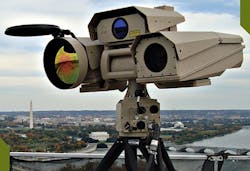Navy awards $2.2 million contract to FLIR to provide IR cameras for military test ranges
CORONA, Calif., 10 Oct. 2014. U.S. Navy surveillance experts are asking FLIR Systems Inc. in Wilsonville, Ore., to provide 25 infrared cameras for weapons practice ranges in the U.S. and Saudi Arabia under terms of a $2.2 million contract announced this week.
Officials of the Range Systems Engineering Branch of the Naval Surface Warfare Center Corona Division in Corona, Calif., are asking FLIR Systems to provide 25 of the company's Ranger HRC electro-optical cameras for air-to-ground training ranges and similar sensitive facilities.
The FLIR Ranger HRC electro-optical camera is a portable, long-range thermal-imaging surveillance system with multi-sensor options. The camera has a cooled ruggedized large-format 640-by-480-pixel indium antimonide infrared detector, autofocus, and 12.5X continuous zoom capability.
Related: Air Force takes aim at short-wave infrared cameras for widespread use in military programs
The long-range, high-resolution infrared cameras are for U.S. and foreign military weapons impact scoring set (WISS) projects at several U.S. and foreign military bases. The WISS is an electro-optical system designed to measure impact location of aircraft-delivered practice bombs and missiles to evaluate pilot performance.
The WISS uses the video of a target area from remote cameras located in two different places, and multiplexes the signals to one video stream for display on one monitor. The system operator uses a joystick to choose one impact from the video. The system can use visible-light cameras for daylight practice sessions, and infrared cameras for nighttime operations at the practice ranges.
FLIR Systems engineers designed the Ranger HRC infrared camera for applications like force protection, border surveillance, tactical reconnaissance, training range applications, fixed and mobile security, target tracking, and long range surveillance.
Related: Special Operations Command asks industry for EO/IR cameras for 14-pound, hand-launched UAV
Military personnel will use the cameras at the Juniper Butte and Saylor Creek ranges at Mountain Home Air Force Base, Idaho; Centennial and Red Rio ranges at Holloman Air Force Base, N.M.; Anwah, Badar, Fahad, and Khurais ranges in Saudi Arabia; Adirondack Range in Upstate New York; BT-11 Range at Cherry Point Marine Corps Air Station, N.C.; and Naval Surface Warfare Center Corona Division in Corona, Calif.
Military combat aircraft pilots use air-to-ground ranges to practice dropping bombs, firing missiles, and firing guns. Often pilots practice with inert munitions, but ranges can accommodate live-fire weapons practice when necessary.
The FLIR Systems Ranger HRC infrared camera is network-enabled, and uses the MPEG4 digital video format. It has long-range optics that are able to detect a man-sized target as far away as six miles, vehicle-sized targets more than 12 miles away.
Related: HGH Infrared Systems to produce IR cameras for use in Afghanistan
The cameras have four times the resolution of mid-format systems for significantly greater range performance and image quality, FLIR officials say. The company's commercially developed, military qualified (CDMQ) process delivers a military quality system, designed to work 24/7/365.
The Ranger HRC system weighs less than 19 pounds, and measures 18.6 by 7.6 by 8.8 inches. Options include laser range finder, digital magnetic compass, and GPS-based geo-pointing and positioning.
For more information contact FLIR Systems online at www.flir.com or the Naval Surface Warfare Center Corona Division at www.navsea.navy.mil/nswc/corona.

